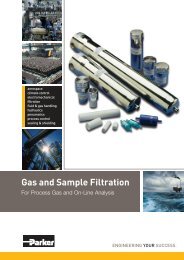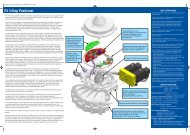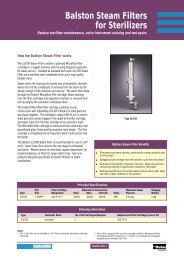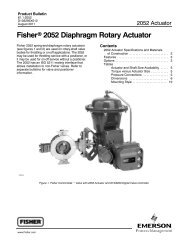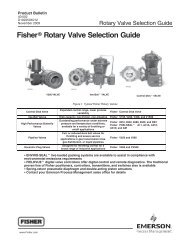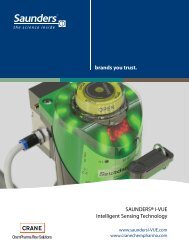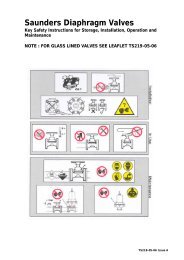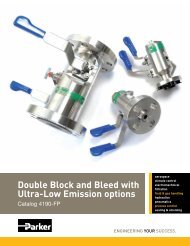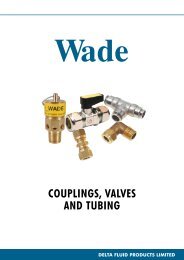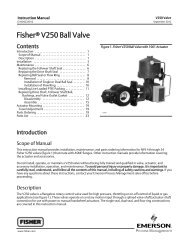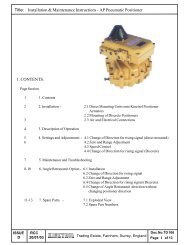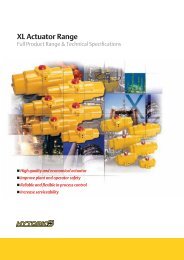Fisher® FIELDVUE DVC6200 Digital Valve Controller
Fisher® FIELDVUE DVC6200 Digital Valve Controller
Fisher® FIELDVUE DVC6200 Digital Valve Controller
Create successful ePaper yourself
Turn your PDF publications into a flip-book with our unique Google optimized e-Paper software.
Glossary<br />
July 2012<br />
Instruction Manual<br />
D103605X012<br />
Minimum Closing Time<br />
Minimum time, in seconds, for the travel to<br />
decrease through the entire ranged travel. This<br />
rate is applied to any travel decrease. Valid entries<br />
are 0 to 400 seconds. Deactivate by entering a<br />
value of 0 seconds.<br />
Minimum Opening Time<br />
Minimum time, in seconds, for the travel to<br />
increase through the entire ranged travel. This<br />
rate is applied to any travel increase. Because of<br />
friction, actual valve travel may not respond in<br />
exactly the same time frame. Valid entries are 0<br />
to 400 seconds. Deactivate by entering a value of<br />
0 seconds.<br />
Non‐Volatile Memory (NVM)<br />
A type of semiconductor memory that retains its<br />
contents even though power is disconnected.<br />
NVM contents can be changed during<br />
configuration unlike ROM which can be changed<br />
only at time of instrument manufacture. NVM<br />
stores configuration restart data.<br />
Parallel<br />
Simultaneous: said of data transmission on two or<br />
more channels at the same time.<br />
Polling Address<br />
Address of the instrument. If the digital valve<br />
controller is used in a point‐to‐point<br />
configuration, set the polling address to 0. If it is<br />
used in a multidrop configuration, or split range<br />
application, set the polling address to a value<br />
from 0 to 15.<br />
Pressure Sensor<br />
A <strong>FIELDVUE</strong> instrument internal device that<br />
senses pneumatic pressure. The <strong>DVC6200</strong> has<br />
three pressure sensors: one to sense supply<br />
pressure and two to sense the output pressures.<br />
Primary Master<br />
Masters are communicating devices. A primary<br />
master is a communicating device permanently<br />
wired to a field instrument. Typically, a<br />
HART‐compatible control system or a computer<br />
running <strong>Valve</strong>Link software is the primary master.<br />
In contrast, a secondary master is not often<br />
permanently wired to a field instrument. The<br />
Field Communicator or a computer running<br />
<strong>Valve</strong>Link software communicating through a<br />
HART modem could be considered a secondary<br />
master.<br />
Note: If one type of master takes an instrument<br />
Out Of Service, the same type must put it In<br />
Service. For example, if a device set up as a<br />
primary master takes an instrument Out Of<br />
Service, a device set up as a primary master must<br />
be used to place the instrument In Service.<br />
Quick Opening<br />
A valve flow characteristic where most of the<br />
change in flow rate takes place for small amounts<br />
of stem travel from the closed position. The flow<br />
characteristic curve is basically linear through the<br />
first 40 percent of stem travel. One of the input<br />
characteristics available for a <strong>FIELDVUE</strong><br />
Instrument. See also, Equal Percentage and<br />
Linear.<br />
Random Access Memory (RAM)<br />
A type of semiconductor memory that is normally<br />
used by the microprocessor during normal<br />
operation that permits rapid retrieval and storage<br />
of programs and data. See also Read Only<br />
Memory (ROM) and Non‐Volatile Memory (NVM).<br />
Rate<br />
Amount of change in output proportional to the<br />
rate of change in input.<br />
Read‐Only Memory (ROM)<br />
A memory in which information is stored at the<br />
time of instrument manufacture. You can<br />
examine but not change ROM contents.<br />
Seat Load<br />
Force exerted on the valve seat, typically<br />
expressed in pounds force per lineal inch of port<br />
circumference. Seat load is determined by shutoff<br />
requirements.<br />
94



